Knowledge Management at Samsung
VerifiedAdded on 2019/10/08
|12
|2614
|346
Report
AI Summary
This report examines Samsung Electronics' knowledge management system (KMS), analyzing its strengths and weaknesses. It identifies knowledge currently captured within the organization, highlighting gaps in infrastructure and communication. The report discusses Samsung's existing KMS, 'Test and Error Management System' (TEMS), and its role in product development. Key challenges include communication issues, resistance to change, and a lack of reward systems. The report utilizes the knowledge gap model to illustrate these challenges and proposes recommendations to improve knowledge sharing, including fostering a knowledge-sharing culture, prioritizing knowledge creation, providing effective training, and developing methods for transferring tacit knowledge. The conclusion emphasizes the need for Samsung to adopt dynamic strategies and advanced technologies to enhance its business outcomes and maintain a competitive edge.
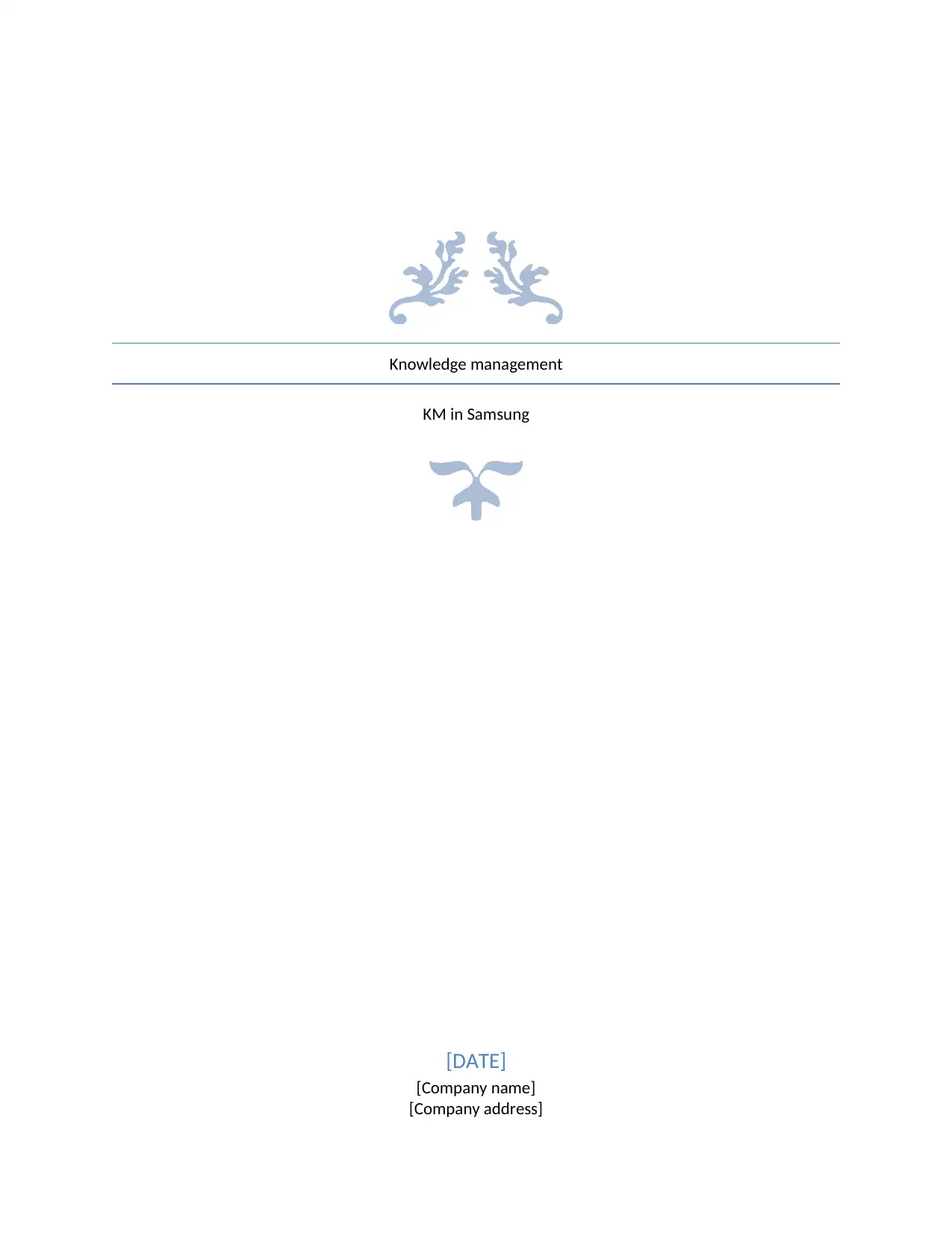
Knowledge management
KM in Samsung
[DATE]
[Company name]
[Company address]
KM in Samsung
[DATE]
[Company name]
[Company address]
Paraphrase This Document
Need a fresh take? Get an instant paraphrase of this document with our AI Paraphraser
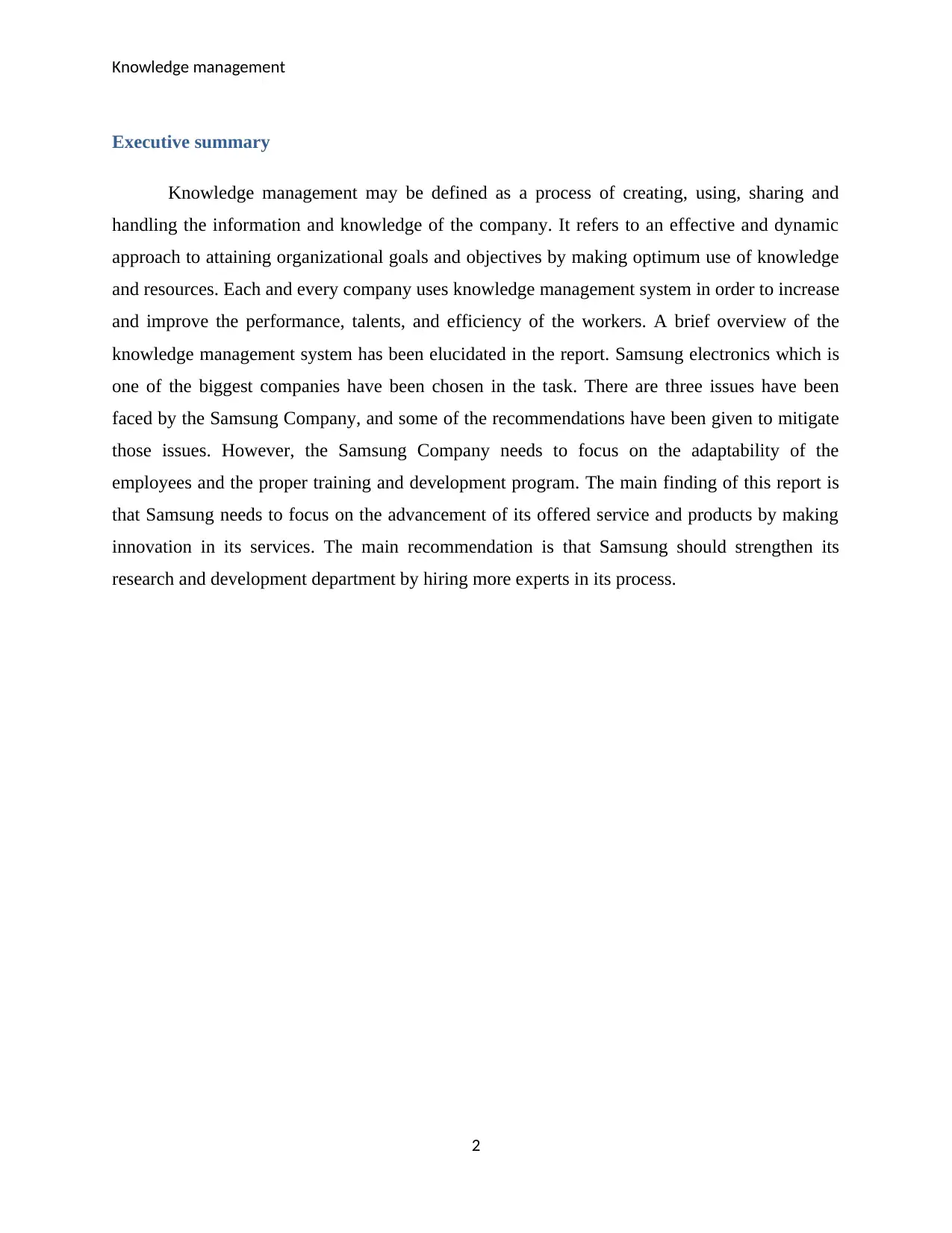
Knowledge management
Executive summary
Knowledge management may be defined as a process of creating, using, sharing and
handling the information and knowledge of the company. It refers to an effective and dynamic
approach to attaining organizational goals and objectives by making optimum use of knowledge
and resources. Each and every company uses knowledge management system in order to increase
and improve the performance, talents, and efficiency of the workers. A brief overview of the
knowledge management system has been elucidated in the report. Samsung electronics which is
one of the biggest companies have been chosen in the task. There are three issues have been
faced by the Samsung Company, and some of the recommendations have been given to mitigate
those issues. However, the Samsung Company needs to focus on the adaptability of the
employees and the proper training and development program. The main finding of this report is
that Samsung needs to focus on the advancement of its offered service and products by making
innovation in its services. The main recommendation is that Samsung should strengthen its
research and development department by hiring more experts in its process.
2
Executive summary
Knowledge management may be defined as a process of creating, using, sharing and
handling the information and knowledge of the company. It refers to an effective and dynamic
approach to attaining organizational goals and objectives by making optimum use of knowledge
and resources. Each and every company uses knowledge management system in order to increase
and improve the performance, talents, and efficiency of the workers. A brief overview of the
knowledge management system has been elucidated in the report. Samsung electronics which is
one of the biggest companies have been chosen in the task. There are three issues have been
faced by the Samsung Company, and some of the recommendations have been given to mitigate
those issues. However, the Samsung Company needs to focus on the adaptability of the
employees and the proper training and development program. The main finding of this report is
that Samsung needs to focus on the advancement of its offered service and products by making
innovation in its services. The main recommendation is that Samsung should strengthen its
research and development department by hiring more experts in its process.
2
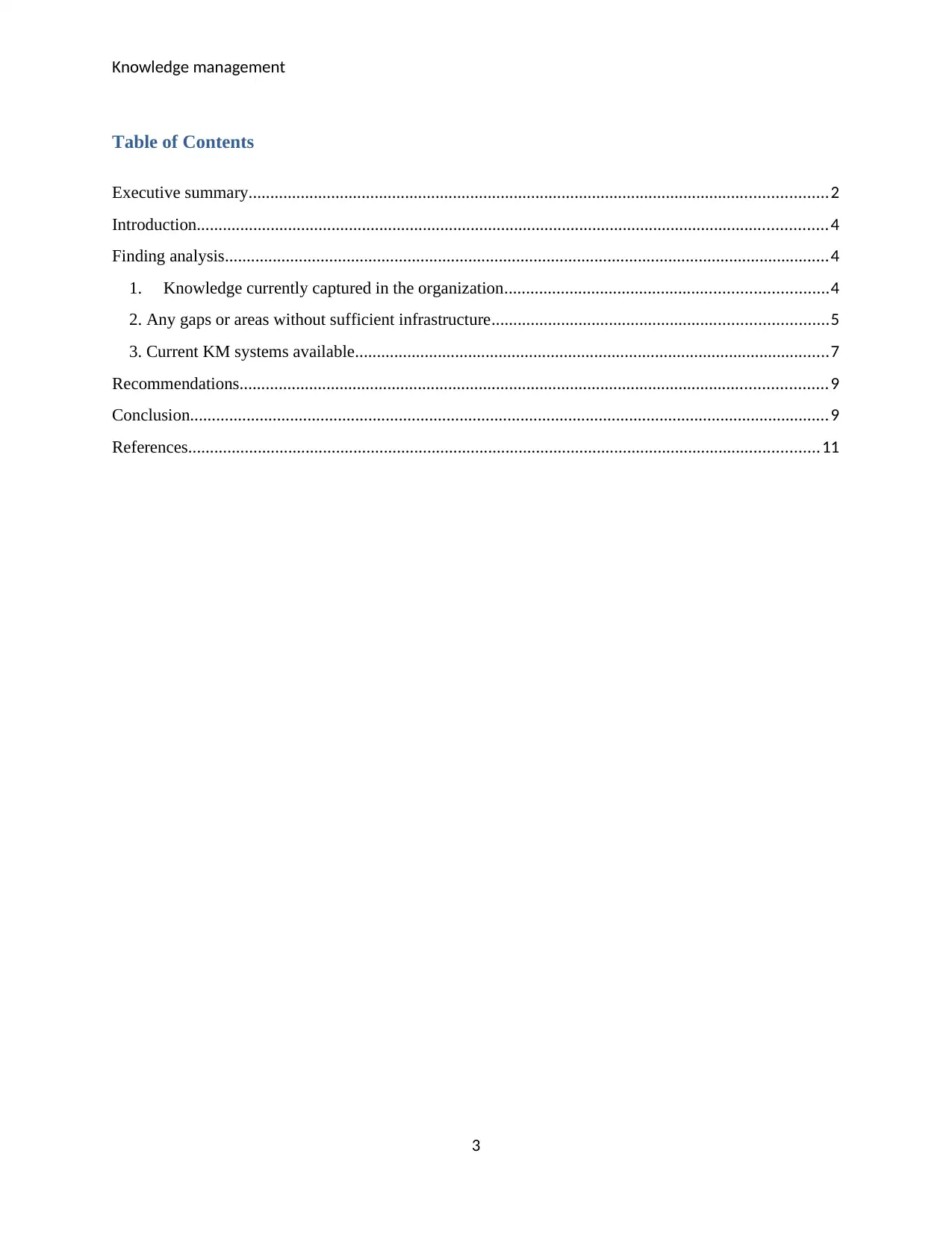
Knowledge management
Table of Contents
Executive summary.....................................................................................................................................2
Introduction.................................................................................................................................................4
Finding analysis...........................................................................................................................................4
1. Knowledge currently captured in the organization..........................................................................4
2. Any gaps or areas without sufficient infrastructure.............................................................................5
3. Current KM systems available.............................................................................................................7
Recommendations.......................................................................................................................................9
Conclusion...................................................................................................................................................9
References.................................................................................................................................................11
3
Table of Contents
Executive summary.....................................................................................................................................2
Introduction.................................................................................................................................................4
Finding analysis...........................................................................................................................................4
1. Knowledge currently captured in the organization..........................................................................4
2. Any gaps or areas without sufficient infrastructure.............................................................................5
3. Current KM systems available.............................................................................................................7
Recommendations.......................................................................................................................................9
Conclusion...................................................................................................................................................9
References.................................................................................................................................................11
3
⊘ This is a preview!⊘
Do you want full access?
Subscribe today to unlock all pages.

Trusted by 1+ million students worldwide
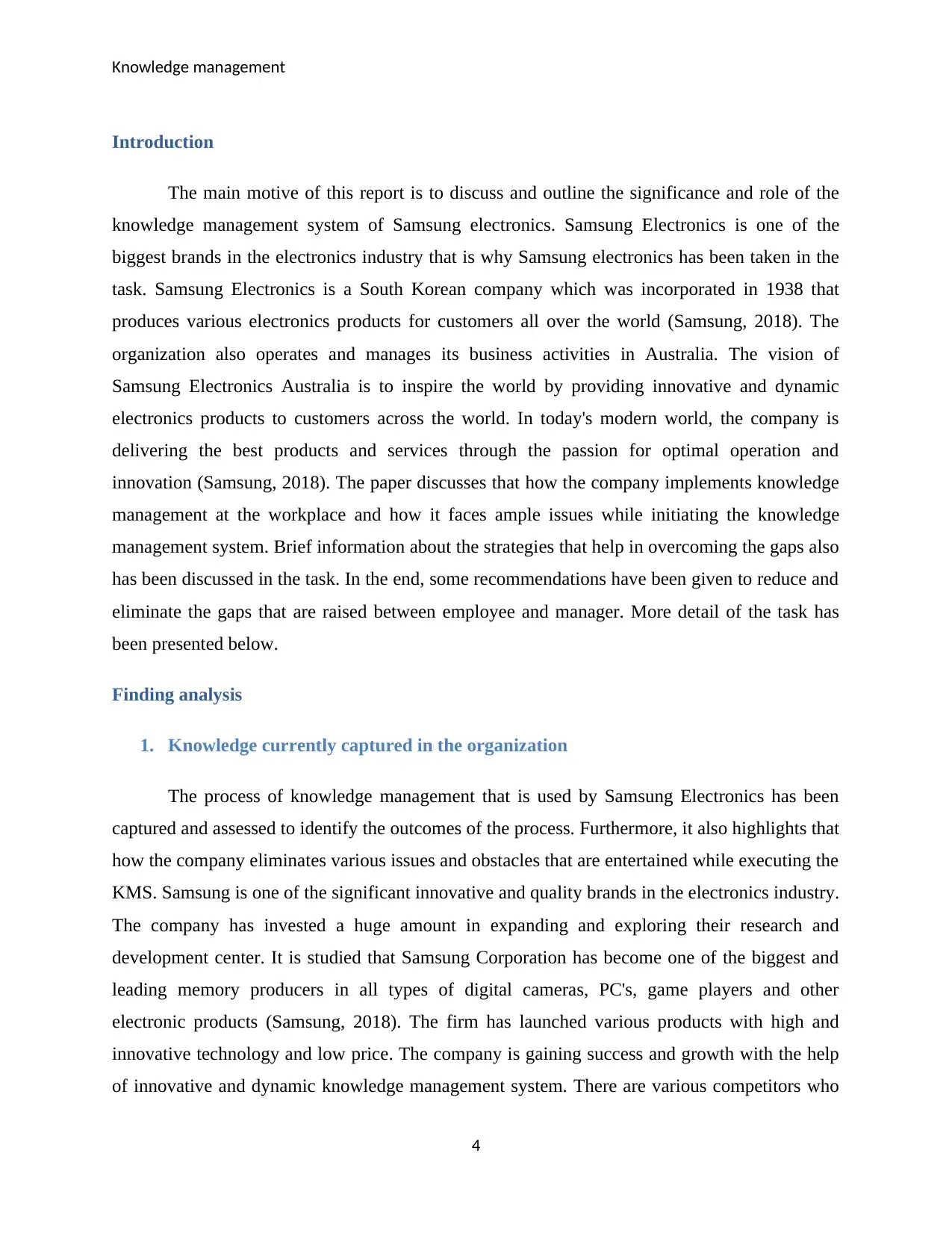
Knowledge management
Introduction
The main motive of this report is to discuss and outline the significance and role of the
knowledge management system of Samsung electronics. Samsung Electronics is one of the
biggest brands in the electronics industry that is why Samsung electronics has been taken in the
task. Samsung Electronics is a South Korean company which was incorporated in 1938 that
produces various electronics products for customers all over the world (Samsung, 2018). The
organization also operates and manages its business activities in Australia. The vision of
Samsung Electronics Australia is to inspire the world by providing innovative and dynamic
electronics products to customers across the world. In today's modern world, the company is
delivering the best products and services through the passion for optimal operation and
innovation (Samsung, 2018). The paper discusses that how the company implements knowledge
management at the workplace and how it faces ample issues while initiating the knowledge
management system. Brief information about the strategies that help in overcoming the gaps also
has been discussed in the task. In the end, some recommendations have been given to reduce and
eliminate the gaps that are raised between employee and manager. More detail of the task has
been presented below.
Finding analysis
1. Knowledge currently captured in the organization
The process of knowledge management that is used by Samsung Electronics has been
captured and assessed to identify the outcomes of the process. Furthermore, it also highlights that
how the company eliminates various issues and obstacles that are entertained while executing the
KMS. Samsung is one of the significant innovative and quality brands in the electronics industry.
The company has invested a huge amount in expanding and exploring their research and
development center. It is studied that Samsung Corporation has become one of the biggest and
leading memory producers in all types of digital cameras, PC's, game players and other
electronic products (Samsung, 2018). The firm has launched various products with high and
innovative technology and low price. The company is gaining success and growth with the help
of innovative and dynamic knowledge management system. There are various competitors who
4
Introduction
The main motive of this report is to discuss and outline the significance and role of the
knowledge management system of Samsung electronics. Samsung Electronics is one of the
biggest brands in the electronics industry that is why Samsung electronics has been taken in the
task. Samsung Electronics is a South Korean company which was incorporated in 1938 that
produces various electronics products for customers all over the world (Samsung, 2018). The
organization also operates and manages its business activities in Australia. The vision of
Samsung Electronics Australia is to inspire the world by providing innovative and dynamic
electronics products to customers across the world. In today's modern world, the company is
delivering the best products and services through the passion for optimal operation and
innovation (Samsung, 2018). The paper discusses that how the company implements knowledge
management at the workplace and how it faces ample issues while initiating the knowledge
management system. Brief information about the strategies that help in overcoming the gaps also
has been discussed in the task. In the end, some recommendations have been given to reduce and
eliminate the gaps that are raised between employee and manager. More detail of the task has
been presented below.
Finding analysis
1. Knowledge currently captured in the organization
The process of knowledge management that is used by Samsung Electronics has been
captured and assessed to identify the outcomes of the process. Furthermore, it also highlights that
how the company eliminates various issues and obstacles that are entertained while executing the
KMS. Samsung is one of the significant innovative and quality brands in the electronics industry.
The company has invested a huge amount in expanding and exploring their research and
development center. It is studied that Samsung Corporation has become one of the biggest and
leading memory producers in all types of digital cameras, PC's, game players and other
electronic products (Samsung, 2018). The firm has launched various products with high and
innovative technology and low price. The company is gaining success and growth with the help
of innovative and dynamic knowledge management system. There are various competitors who
4
Paraphrase This Document
Need a fresh take? Get an instant paraphrase of this document with our AI Paraphraser
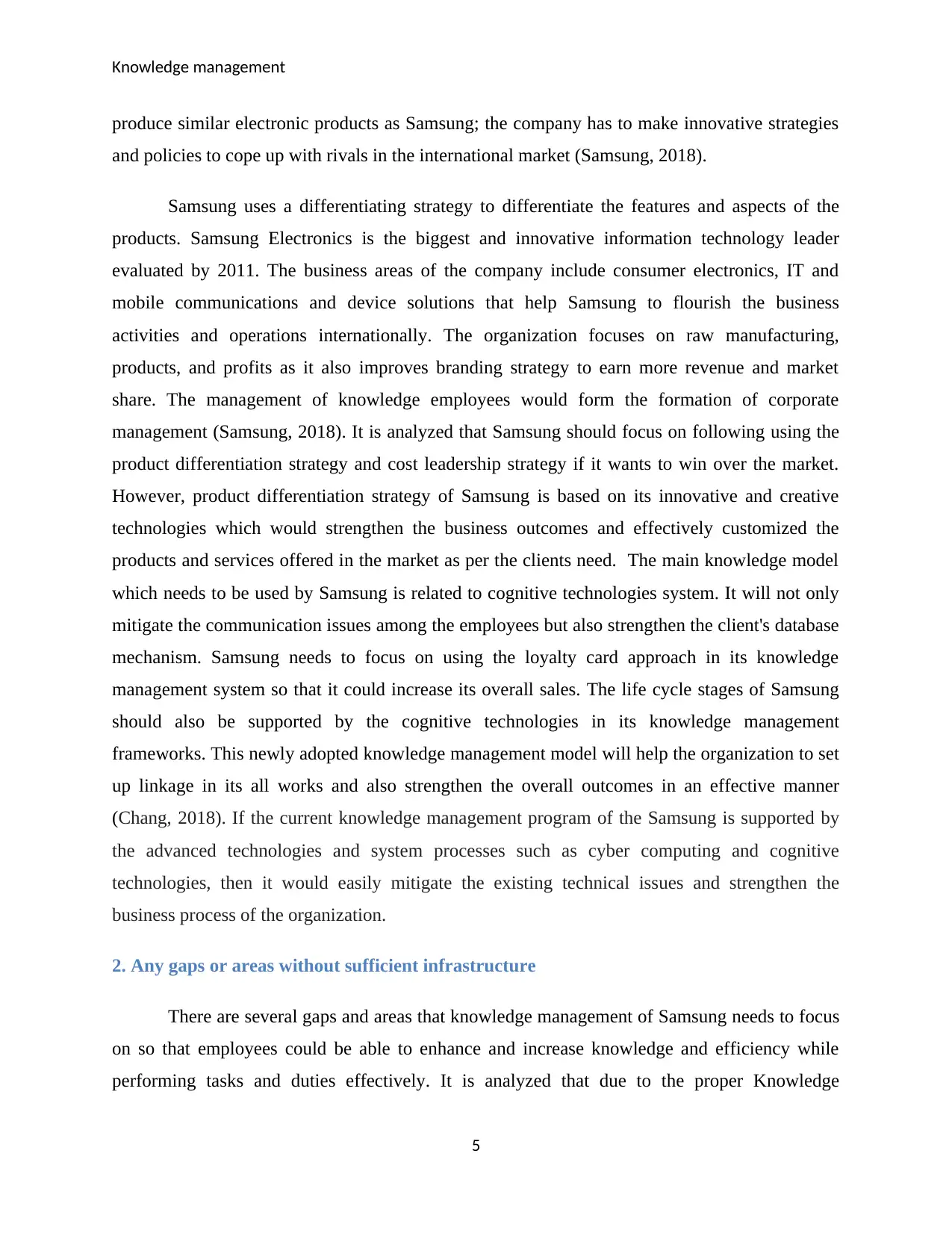
Knowledge management
produce similar electronic products as Samsung; the company has to make innovative strategies
and policies to cope up with rivals in the international market (Samsung, 2018).
Samsung uses a differentiating strategy to differentiate the features and aspects of the
products. Samsung Electronics is the biggest and innovative information technology leader
evaluated by 2011. The business areas of the company include consumer electronics, IT and
mobile communications and device solutions that help Samsung to flourish the business
activities and operations internationally. The organization focuses on raw manufacturing,
products, and profits as it also improves branding strategy to earn more revenue and market
share. The management of knowledge employees would form the formation of corporate
management (Samsung, 2018). It is analyzed that Samsung should focus on following using the
product differentiation strategy and cost leadership strategy if it wants to win over the market.
However, product differentiation strategy of Samsung is based on its innovative and creative
technologies which would strengthen the business outcomes and effectively customized the
products and services offered in the market as per the clients need. The main knowledge model
which needs to be used by Samsung is related to cognitive technologies system. It will not only
mitigate the communication issues among the employees but also strengthen the client's database
mechanism. Samsung needs to focus on using the loyalty card approach in its knowledge
management system so that it could increase its overall sales. The life cycle stages of Samsung
should also be supported by the cognitive technologies in its knowledge management
frameworks. This newly adopted knowledge management model will help the organization to set
up linkage in its all works and also strengthen the overall outcomes in an effective manner
(Chang, 2018). If the current knowledge management program of the Samsung is supported by
the advanced technologies and system processes such as cyber computing and cognitive
technologies, then it would easily mitigate the existing technical issues and strengthen the
business process of the organization.
2. Any gaps or areas without sufficient infrastructure
There are several gaps and areas that knowledge management of Samsung needs to focus
on so that employees could be able to enhance and increase knowledge and efficiency while
performing tasks and duties effectively. It is analyzed that due to the proper Knowledge
5
produce similar electronic products as Samsung; the company has to make innovative strategies
and policies to cope up with rivals in the international market (Samsung, 2018).
Samsung uses a differentiating strategy to differentiate the features and aspects of the
products. Samsung Electronics is the biggest and innovative information technology leader
evaluated by 2011. The business areas of the company include consumer electronics, IT and
mobile communications and device solutions that help Samsung to flourish the business
activities and operations internationally. The organization focuses on raw manufacturing,
products, and profits as it also improves branding strategy to earn more revenue and market
share. The management of knowledge employees would form the formation of corporate
management (Samsung, 2018). It is analyzed that Samsung should focus on following using the
product differentiation strategy and cost leadership strategy if it wants to win over the market.
However, product differentiation strategy of Samsung is based on its innovative and creative
technologies which would strengthen the business outcomes and effectively customized the
products and services offered in the market as per the clients need. The main knowledge model
which needs to be used by Samsung is related to cognitive technologies system. It will not only
mitigate the communication issues among the employees but also strengthen the client's database
mechanism. Samsung needs to focus on using the loyalty card approach in its knowledge
management system so that it could increase its overall sales. The life cycle stages of Samsung
should also be supported by the cognitive technologies in its knowledge management
frameworks. This newly adopted knowledge management model will help the organization to set
up linkage in its all works and also strengthen the overall outcomes in an effective manner
(Chang, 2018). If the current knowledge management program of the Samsung is supported by
the advanced technologies and system processes such as cyber computing and cognitive
technologies, then it would easily mitigate the existing technical issues and strengthen the
business process of the organization.
2. Any gaps or areas without sufficient infrastructure
There are several gaps and areas that knowledge management of Samsung needs to focus
on so that employees could be able to enhance and increase knowledge and efficiency while
performing tasks and duties effectively. It is analyzed that due to the proper Knowledge
5
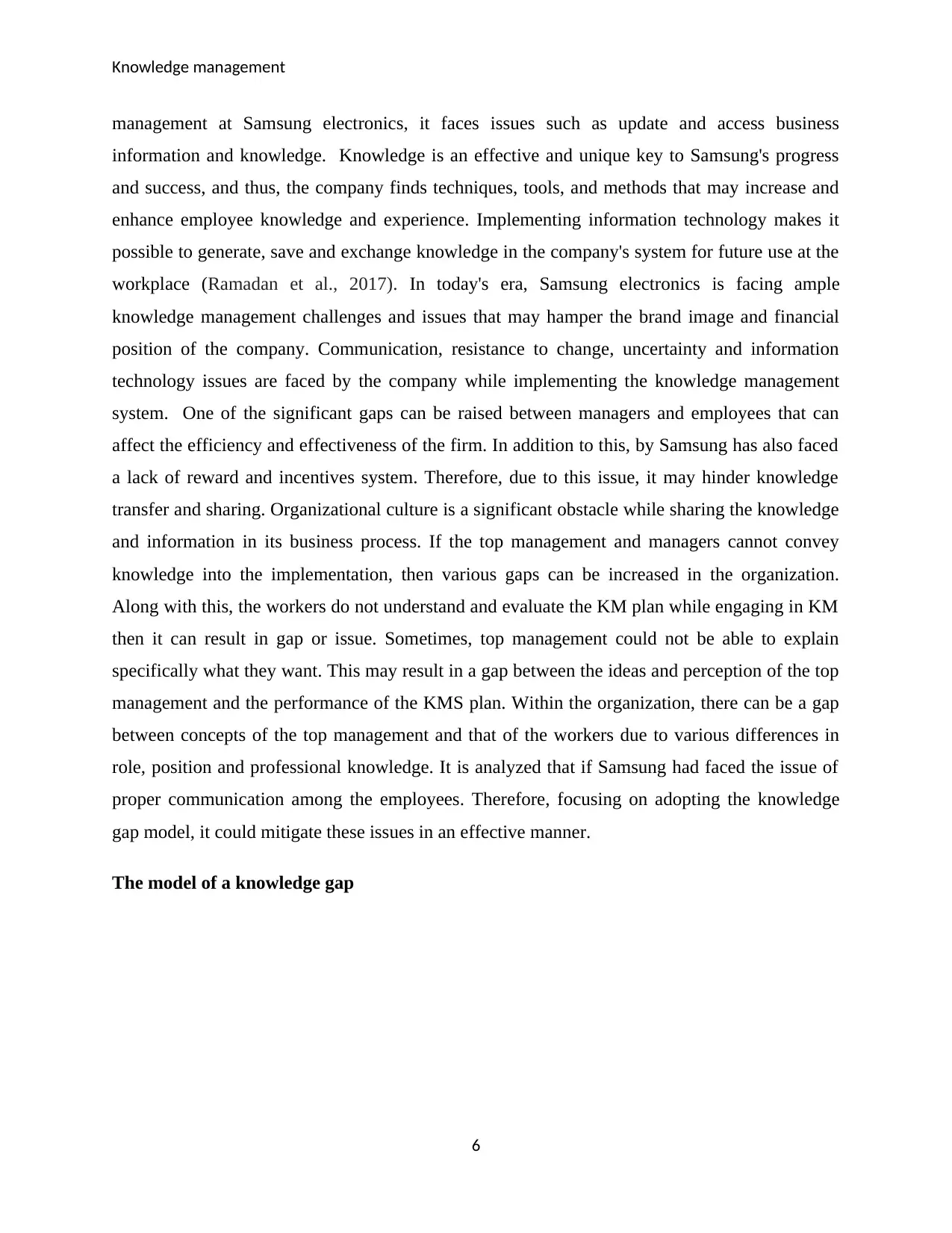
Knowledge management
management at Samsung electronics, it faces issues such as update and access business
information and knowledge. Knowledge is an effective and unique key to Samsung's progress
and success, and thus, the company finds techniques, tools, and methods that may increase and
enhance employee knowledge and experience. Implementing information technology makes it
possible to generate, save and exchange knowledge in the company's system for future use at the
workplace (Ramadan et al., 2017). In today's era, Samsung electronics is facing ample
knowledge management challenges and issues that may hamper the brand image and financial
position of the company. Communication, resistance to change, uncertainty and information
technology issues are faced by the company while implementing the knowledge management
system. One of the significant gaps can be raised between managers and employees that can
affect the efficiency and effectiveness of the firm. In addition to this, by Samsung has also faced
a lack of reward and incentives system. Therefore, due to this issue, it may hinder knowledge
transfer and sharing. Organizational culture is a significant obstacle while sharing the knowledge
and information in its business process. If the top management and managers cannot convey
knowledge into the implementation, then various gaps can be increased in the organization.
Along with this, the workers do not understand and evaluate the KM plan while engaging in KM
then it can result in gap or issue. Sometimes, top management could not be able to explain
specifically what they want. This may result in a gap between the ideas and perception of the top
management and the performance of the KMS plan. Within the organization, there can be a gap
between concepts of the top management and that of the workers due to various differences in
role, position and professional knowledge. It is analyzed that if Samsung had faced the issue of
proper communication among the employees. Therefore, focusing on adopting the knowledge
gap model, it could mitigate these issues in an effective manner.
The model of a knowledge gap
6
management at Samsung electronics, it faces issues such as update and access business
information and knowledge. Knowledge is an effective and unique key to Samsung's progress
and success, and thus, the company finds techniques, tools, and methods that may increase and
enhance employee knowledge and experience. Implementing information technology makes it
possible to generate, save and exchange knowledge in the company's system for future use at the
workplace (Ramadan et al., 2017). In today's era, Samsung electronics is facing ample
knowledge management challenges and issues that may hamper the brand image and financial
position of the company. Communication, resistance to change, uncertainty and information
technology issues are faced by the company while implementing the knowledge management
system. One of the significant gaps can be raised between managers and employees that can
affect the efficiency and effectiveness of the firm. In addition to this, by Samsung has also faced
a lack of reward and incentives system. Therefore, due to this issue, it may hinder knowledge
transfer and sharing. Organizational culture is a significant obstacle while sharing the knowledge
and information in its business process. If the top management and managers cannot convey
knowledge into the implementation, then various gaps can be increased in the organization.
Along with this, the workers do not understand and evaluate the KM plan while engaging in KM
then it can result in gap or issue. Sometimes, top management could not be able to explain
specifically what they want. This may result in a gap between the ideas and perception of the top
management and the performance of the KMS plan. Within the organization, there can be a gap
between concepts of the top management and that of the workers due to various differences in
role, position and professional knowledge. It is analyzed that if Samsung had faced the issue of
proper communication among the employees. Therefore, focusing on adopting the knowledge
gap model, it could mitigate these issues in an effective manner.
The model of a knowledge gap
6
⊘ This is a preview!⊘
Do you want full access?
Subscribe today to unlock all pages.

Trusted by 1+ million students worldwide
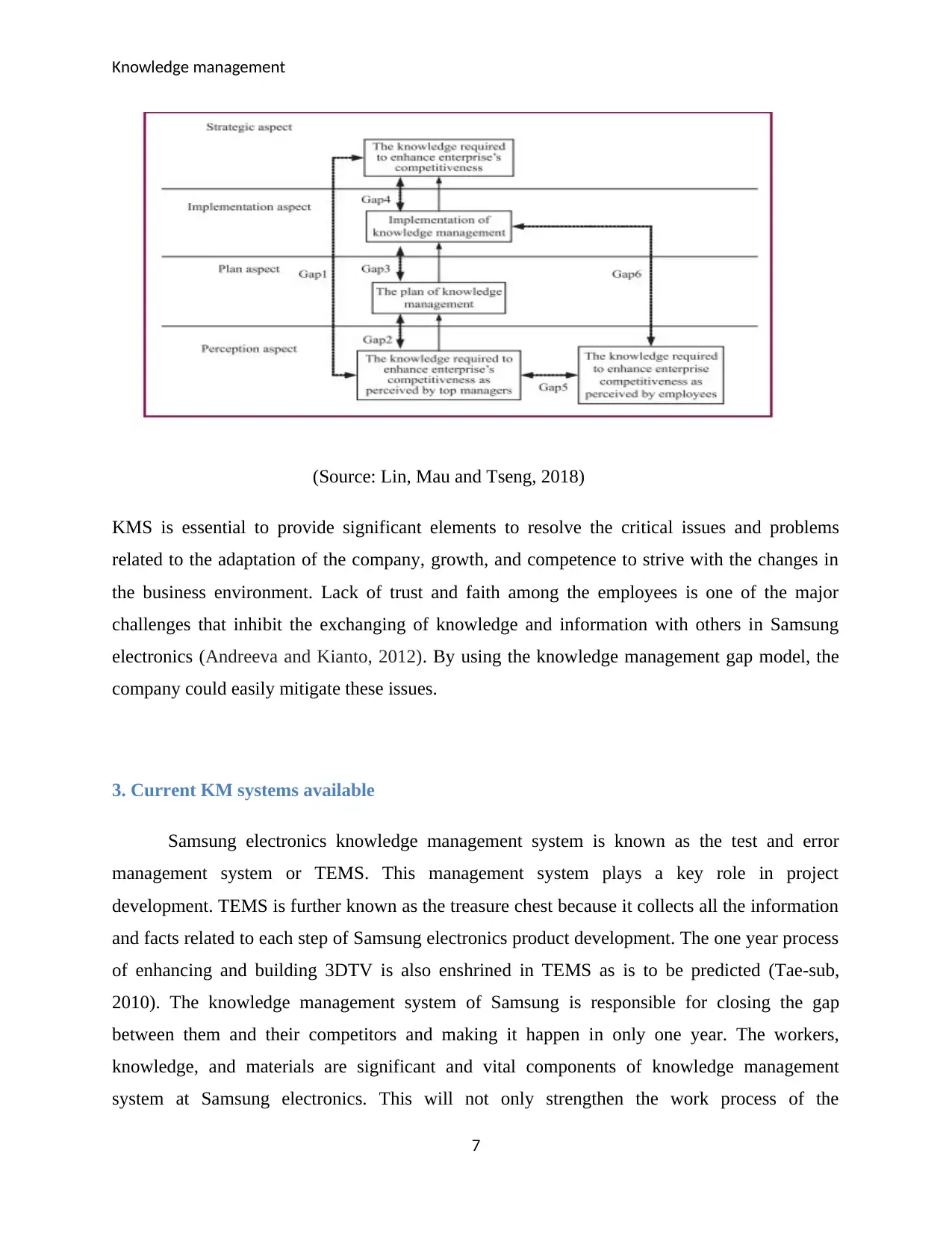
Knowledge management
(Source: Lin, Mau and Tseng, 2018)
KMS is essential to provide significant elements to resolve the critical issues and problems
related to the adaptation of the company, growth, and competence to strive with the changes in
the business environment. Lack of trust and faith among the employees is one of the major
challenges that inhibit the exchanging of knowledge and information with others in Samsung
electronics (Andreeva and Kianto, 2012). By using the knowledge management gap model, the
company could easily mitigate these issues.
3. Current KM systems available
Samsung electronics knowledge management system is known as the test and error
management system or TEMS. This management system plays a key role in project
development. TEMS is further known as the treasure chest because it collects all the information
and facts related to each step of Samsung electronics product development. The one year process
of enhancing and building 3DTV is also enshrined in TEMS as is to be predicted (Tae-sub,
2010). The knowledge management system of Samsung is responsible for closing the gap
between them and their competitors and making it happen in only one year. The workers,
knowledge, and materials are significant and vital components of knowledge management
system at Samsung electronics. This will not only strengthen the work process of the
7
(Source: Lin, Mau and Tseng, 2018)
KMS is essential to provide significant elements to resolve the critical issues and problems
related to the adaptation of the company, growth, and competence to strive with the changes in
the business environment. Lack of trust and faith among the employees is one of the major
challenges that inhibit the exchanging of knowledge and information with others in Samsung
electronics (Andreeva and Kianto, 2012). By using the knowledge management gap model, the
company could easily mitigate these issues.
3. Current KM systems available
Samsung electronics knowledge management system is known as the test and error
management system or TEMS. This management system plays a key role in project
development. TEMS is further known as the treasure chest because it collects all the information
and facts related to each step of Samsung electronics product development. The one year process
of enhancing and building 3DTV is also enshrined in TEMS as is to be predicted (Tae-sub,
2010). The knowledge management system of Samsung is responsible for closing the gap
between them and their competitors and making it happen in only one year. The workers,
knowledge, and materials are significant and vital components of knowledge management
system at Samsung electronics. This will not only strengthen the work process of the
7
Paraphrase This Document
Need a fresh take? Get an instant paraphrase of this document with our AI Paraphraser
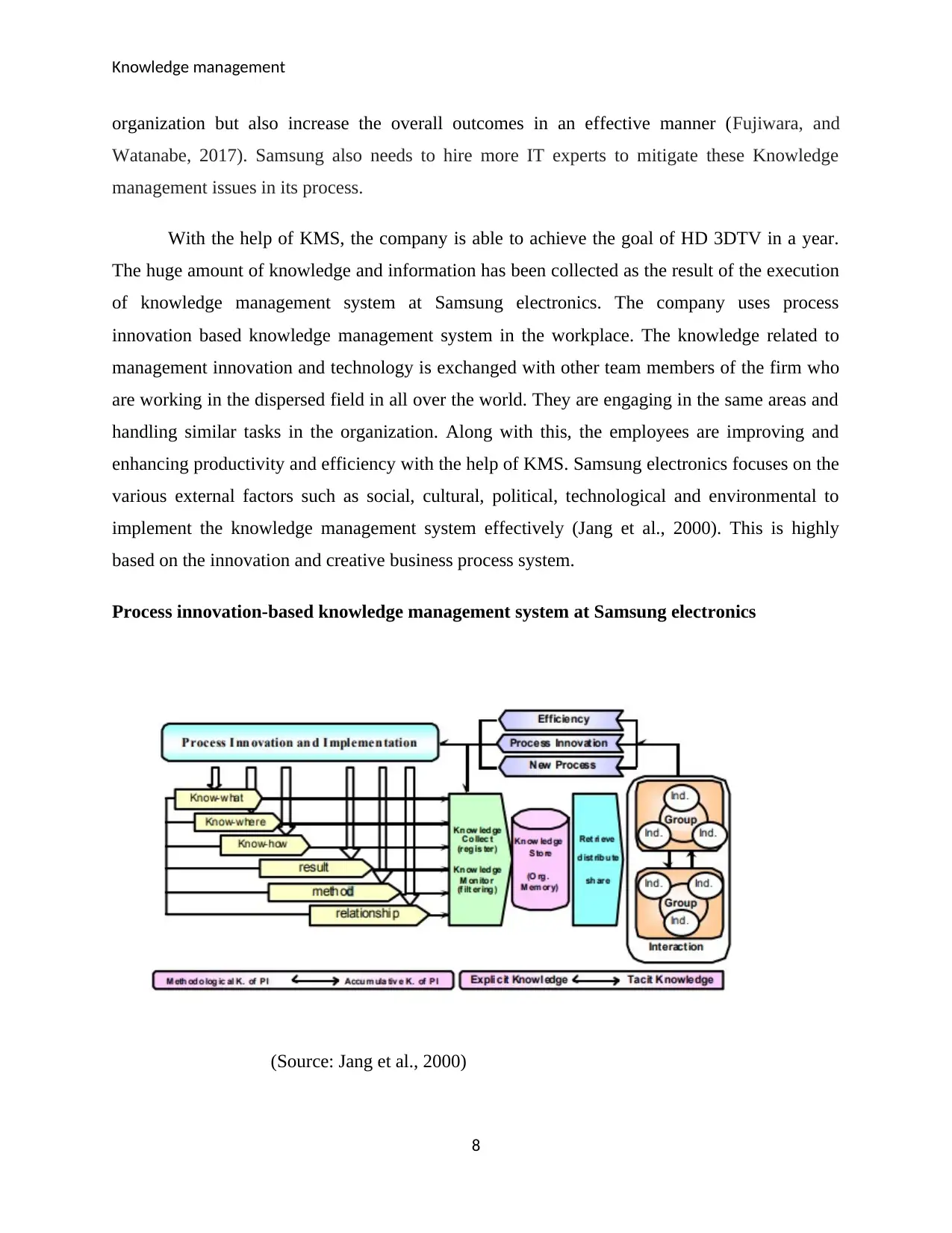
Knowledge management
organization but also increase the overall outcomes in an effective manner (Fujiwara, and
Watanabe, 2017). Samsung also needs to hire more IT experts to mitigate these Knowledge
management issues in its process.
With the help of KMS, the company is able to achieve the goal of HD 3DTV in a year.
The huge amount of knowledge and information has been collected as the result of the execution
of knowledge management system at Samsung electronics. The company uses process
innovation based knowledge management system in the workplace. The knowledge related to
management innovation and technology is exchanged with other team members of the firm who
are working in the dispersed field in all over the world. They are engaging in the same areas and
handling similar tasks in the organization. Along with this, the employees are improving and
enhancing productivity and efficiency with the help of KMS. Samsung electronics focuses on the
various external factors such as social, cultural, political, technological and environmental to
implement the knowledge management system effectively (Jang et al., 2000). This is highly
based on the innovation and creative business process system.
Process innovation-based knowledge management system at Samsung electronics
(Source: Jang et al., 2000)
8
organization but also increase the overall outcomes in an effective manner (Fujiwara, and
Watanabe, 2017). Samsung also needs to hire more IT experts to mitigate these Knowledge
management issues in its process.
With the help of KMS, the company is able to achieve the goal of HD 3DTV in a year.
The huge amount of knowledge and information has been collected as the result of the execution
of knowledge management system at Samsung electronics. The company uses process
innovation based knowledge management system in the workplace. The knowledge related to
management innovation and technology is exchanged with other team members of the firm who
are working in the dispersed field in all over the world. They are engaging in the same areas and
handling similar tasks in the organization. Along with this, the employees are improving and
enhancing productivity and efficiency with the help of KMS. Samsung electronics focuses on the
various external factors such as social, cultural, political, technological and environmental to
implement the knowledge management system effectively (Jang et al., 2000). This is highly
based on the innovation and creative business process system.
Process innovation-based knowledge management system at Samsung electronics
(Source: Jang et al., 2000)
8
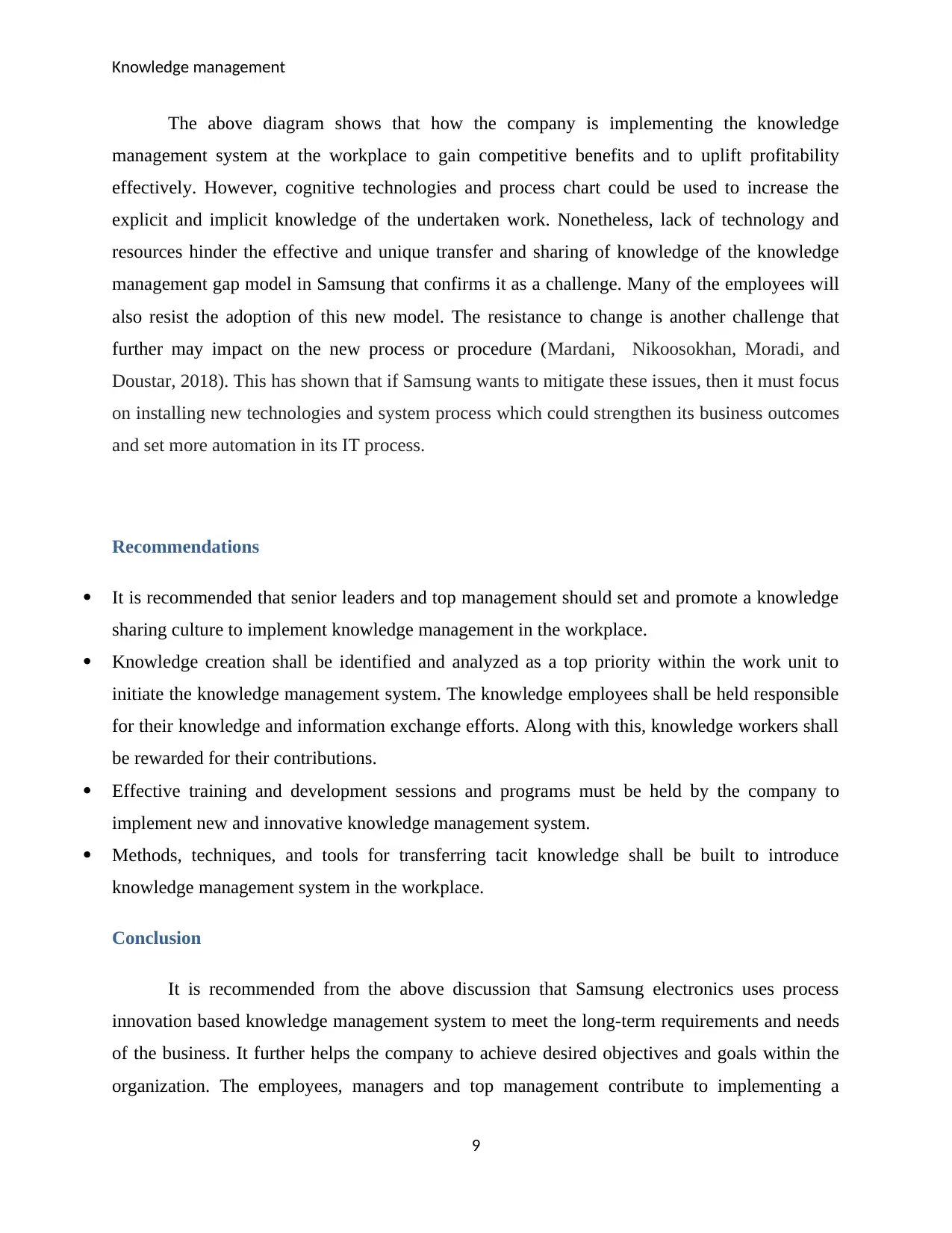
Knowledge management
The above diagram shows that how the company is implementing the knowledge
management system at the workplace to gain competitive benefits and to uplift profitability
effectively. However, cognitive technologies and process chart could be used to increase the
explicit and implicit knowledge of the undertaken work. Nonetheless, lack of technology and
resources hinder the effective and unique transfer and sharing of knowledge of the knowledge
management gap model in Samsung that confirms it as a challenge. Many of the employees will
also resist the adoption of this new model. The resistance to change is another challenge that
further may impact on the new process or procedure (Mardani, Nikoosokhan, Moradi, and
Doustar, 2018). This has shown that if Samsung wants to mitigate these issues, then it must focus
on installing new technologies and system process which could strengthen its business outcomes
and set more automation in its IT process.
Recommendations
It is recommended that senior leaders and top management should set and promote a knowledge
sharing culture to implement knowledge management in the workplace.
Knowledge creation shall be identified and analyzed as a top priority within the work unit to
initiate the knowledge management system. The knowledge employees shall be held responsible
for their knowledge and information exchange efforts. Along with this, knowledge workers shall
be rewarded for their contributions.
Effective training and development sessions and programs must be held by the company to
implement new and innovative knowledge management system.
Methods, techniques, and tools for transferring tacit knowledge shall be built to introduce
knowledge management system in the workplace.
Conclusion
It is recommended from the above discussion that Samsung electronics uses process
innovation based knowledge management system to meet the long-term requirements and needs
of the business. It further helps the company to achieve desired objectives and goals within the
organization. The employees, managers and top management contribute to implementing a
9
The above diagram shows that how the company is implementing the knowledge
management system at the workplace to gain competitive benefits and to uplift profitability
effectively. However, cognitive technologies and process chart could be used to increase the
explicit and implicit knowledge of the undertaken work. Nonetheless, lack of technology and
resources hinder the effective and unique transfer and sharing of knowledge of the knowledge
management gap model in Samsung that confirms it as a challenge. Many of the employees will
also resist the adoption of this new model. The resistance to change is another challenge that
further may impact on the new process or procedure (Mardani, Nikoosokhan, Moradi, and
Doustar, 2018). This has shown that if Samsung wants to mitigate these issues, then it must focus
on installing new technologies and system process which could strengthen its business outcomes
and set more automation in its IT process.
Recommendations
It is recommended that senior leaders and top management should set and promote a knowledge
sharing culture to implement knowledge management in the workplace.
Knowledge creation shall be identified and analyzed as a top priority within the work unit to
initiate the knowledge management system. The knowledge employees shall be held responsible
for their knowledge and information exchange efforts. Along with this, knowledge workers shall
be rewarded for their contributions.
Effective training and development sessions and programs must be held by the company to
implement new and innovative knowledge management system.
Methods, techniques, and tools for transferring tacit knowledge shall be built to introduce
knowledge management system in the workplace.
Conclusion
It is recommended from the above discussion that Samsung electronics uses process
innovation based knowledge management system to meet the long-term requirements and needs
of the business. It further helps the company to achieve desired objectives and goals within the
organization. The employees, managers and top management contribute to implementing a
9
⊘ This is a preview!⊘
Do you want full access?
Subscribe today to unlock all pages.

Trusted by 1+ million students worldwide
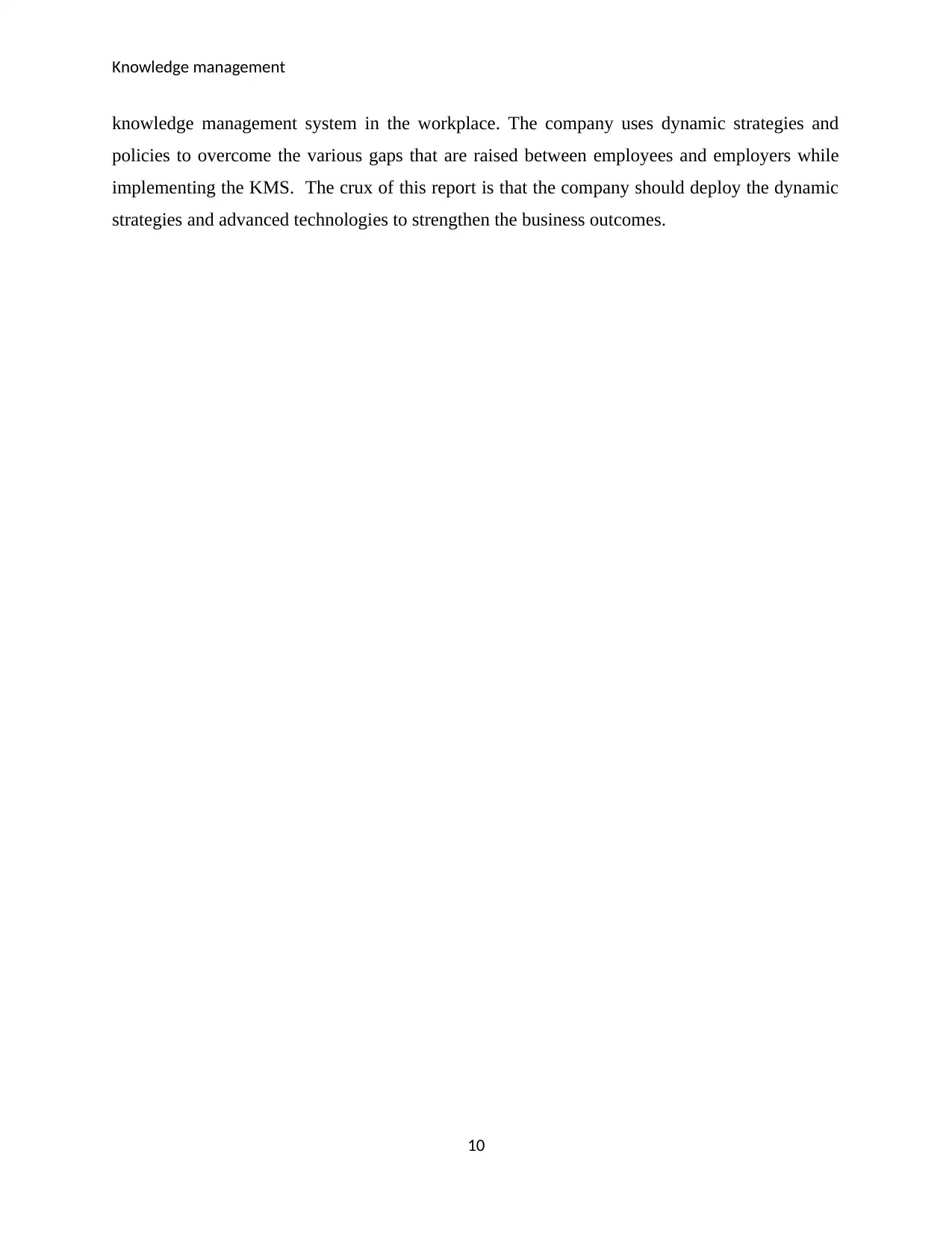
Knowledge management
knowledge management system in the workplace. The company uses dynamic strategies and
policies to overcome the various gaps that are raised between employees and employers while
implementing the KMS. The crux of this report is that the company should deploy the dynamic
strategies and advanced technologies to strengthen the business outcomes.
10
knowledge management system in the workplace. The company uses dynamic strategies and
policies to overcome the various gaps that are raised between employees and employers while
implementing the KMS. The crux of this report is that the company should deploy the dynamic
strategies and advanced technologies to strengthen the business outcomes.
10
Paraphrase This Document
Need a fresh take? Get an instant paraphrase of this document with our AI Paraphraser

Knowledge management
References
Andreeva, T. and Kianto, A., 2012. Does knowledge management really matter? Linking
knowledge management practices, competitiveness, and economic performance. Journal of
knowledge management, 16(4), pp.617-636.
Jang.S., Hong.K., Bock.G.W., and Kim.I.2000. Knowledge management and process innovation:
The knowledge transformation path in the information space (Online). Available from
https://pdfs.semanticscholar.org/5ceb/9caac53f7100e7bcde3de962f450f1fd95a1.pdf [Accessed
as on 15th December 2018].
Lin.C., Mau.J, and Tseng.M.S.2018. Case study on knowledge management gaps (Online).
Available from http://citeseerx.ist.psu.edu/viewdoc/download?
doi=10.1.1.615.8108&rep=rep1&type=pdf [Accessed as on 15th December 2018].
Samsung.2018. About us (Online). Available from
https://www.samsung.com/us/aboutsamsung/company/executives/ceo/ [Accessed as on 16th
December 2018].
Tae-sub.K.2010. Samsung electronics knowledge management system(Online). Available from
http://www.koreaittimes.com/news/articleView.html?idxno=10828 [Accessed as on 15th
December 2018].
Ramadan, B.M., Dahiyat, S.E., Bontis, N. and Al-Dalahmeh, M.A., 2017. Intellectual capital,
knowledge management and social capital within the ICT sector in Jordan. Journal of
Intellectual Capital, 18(2), pp.437-462.
Chang, Y., 2018. Managing Convergence in Innovation. Edited by Kong‐Rae Lee. Routledge:
Abingdon, 2017, ISBN 978‐1138191938, hardback,£ 110, pp. 166. R&D Management, 48(3),
pp.375-376.
Fujiwara, A. and Watanabe, T., 2017. Knowledge management using external
knowledge. International Journal of Innovation Management, 21(04), p.1750031.
11
References
Andreeva, T. and Kianto, A., 2012. Does knowledge management really matter? Linking
knowledge management practices, competitiveness, and economic performance. Journal of
knowledge management, 16(4), pp.617-636.
Jang.S., Hong.K., Bock.G.W., and Kim.I.2000. Knowledge management and process innovation:
The knowledge transformation path in the information space (Online). Available from
https://pdfs.semanticscholar.org/5ceb/9caac53f7100e7bcde3de962f450f1fd95a1.pdf [Accessed
as on 15th December 2018].
Lin.C., Mau.J, and Tseng.M.S.2018. Case study on knowledge management gaps (Online).
Available from http://citeseerx.ist.psu.edu/viewdoc/download?
doi=10.1.1.615.8108&rep=rep1&type=pdf [Accessed as on 15th December 2018].
Samsung.2018. About us (Online). Available from
https://www.samsung.com/us/aboutsamsung/company/executives/ceo/ [Accessed as on 16th
December 2018].
Tae-sub.K.2010. Samsung electronics knowledge management system(Online). Available from
http://www.koreaittimes.com/news/articleView.html?idxno=10828 [Accessed as on 15th
December 2018].
Ramadan, B.M., Dahiyat, S.E., Bontis, N. and Al-Dalahmeh, M.A., 2017. Intellectual capital,
knowledge management and social capital within the ICT sector in Jordan. Journal of
Intellectual Capital, 18(2), pp.437-462.
Chang, Y., 2018. Managing Convergence in Innovation. Edited by Kong‐Rae Lee. Routledge:
Abingdon, 2017, ISBN 978‐1138191938, hardback,£ 110, pp. 166. R&D Management, 48(3),
pp.375-376.
Fujiwara, A. and Watanabe, T., 2017. Knowledge management using external
knowledge. International Journal of Innovation Management, 21(04), p.1750031.
11
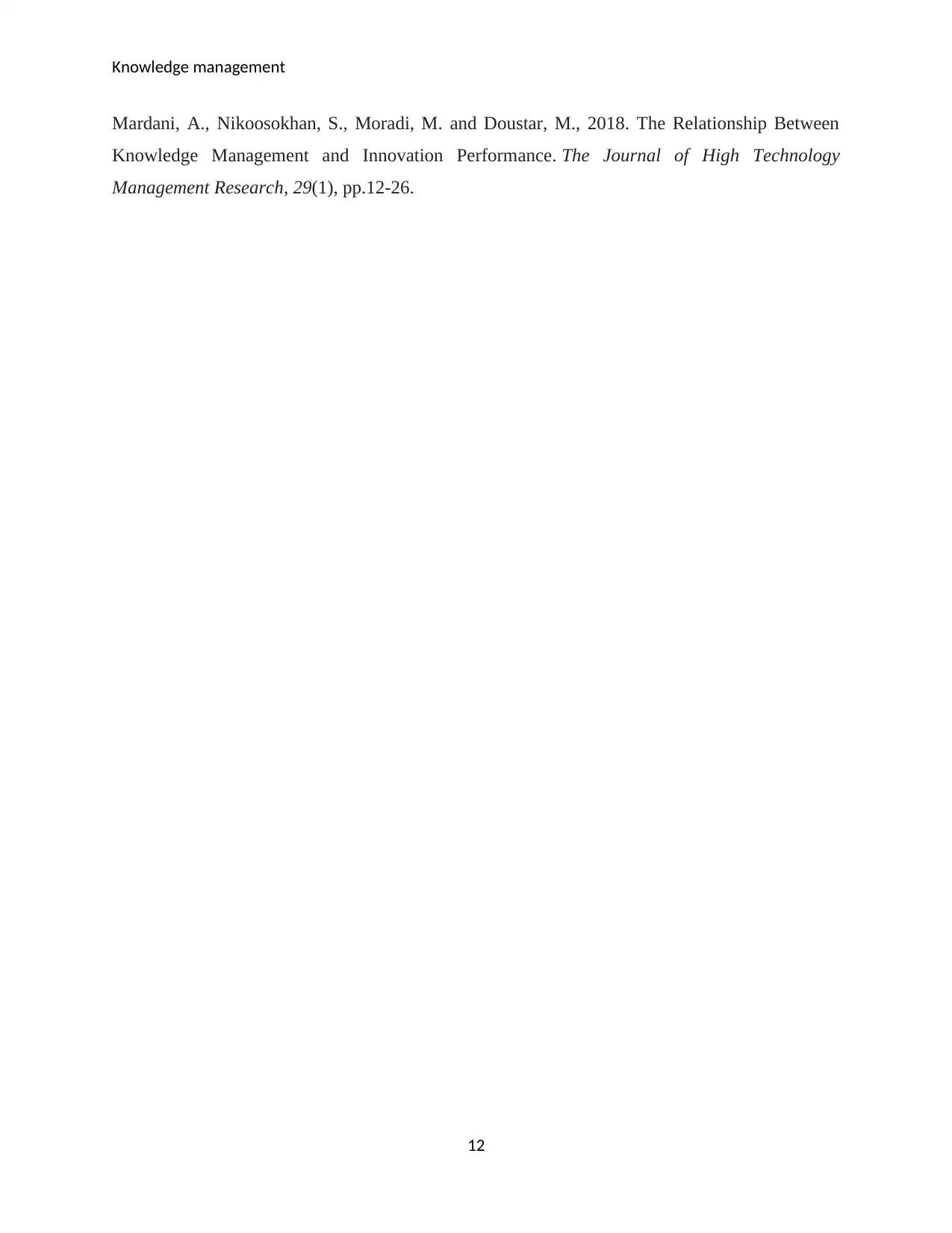
Knowledge management
Mardani, A., Nikoosokhan, S., Moradi, M. and Doustar, M., 2018. The Relationship Between
Knowledge Management and Innovation Performance. The Journal of High Technology
Management Research, 29(1), pp.12-26.
12
Mardani, A., Nikoosokhan, S., Moradi, M. and Doustar, M., 2018. The Relationship Between
Knowledge Management and Innovation Performance. The Journal of High Technology
Management Research, 29(1), pp.12-26.
12
⊘ This is a preview!⊘
Do you want full access?
Subscribe today to unlock all pages.

Trusted by 1+ million students worldwide
1 out of 12
Related Documents
Your All-in-One AI-Powered Toolkit for Academic Success.
+13062052269
info@desklib.com
Available 24*7 on WhatsApp / Email
![[object Object]](/_next/static/media/star-bottom.7253800d.svg)
Unlock your academic potential
© 2024 | Zucol Services PVT LTD | All rights reserved.





